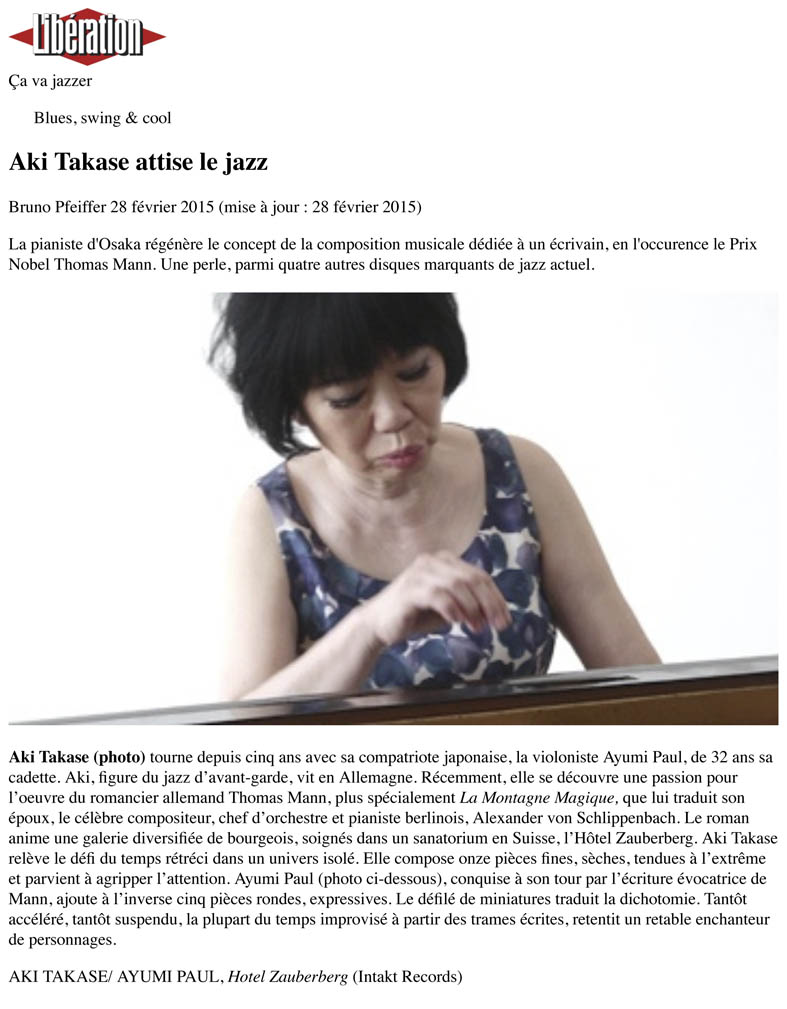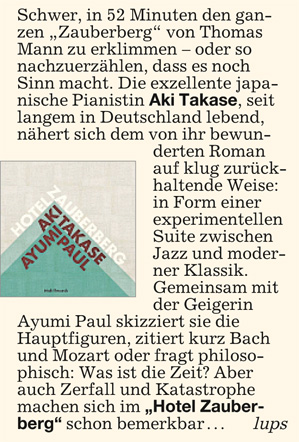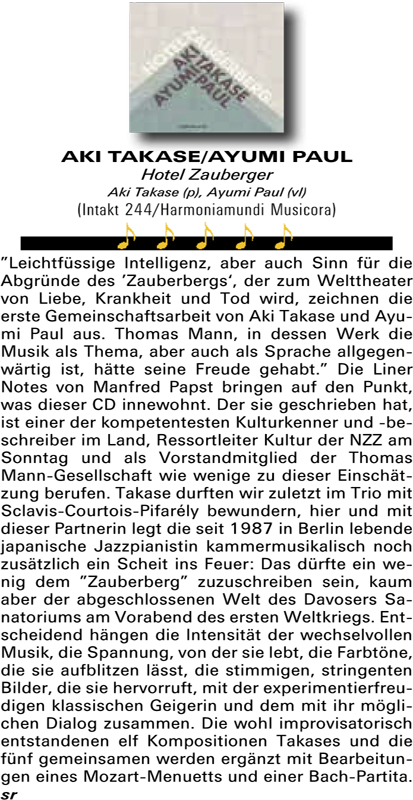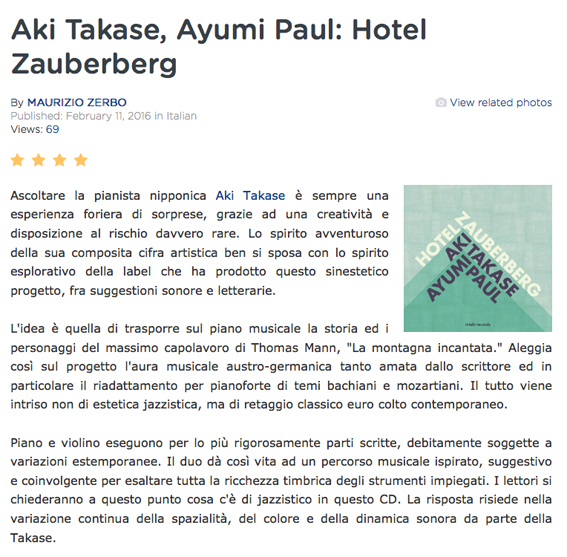INTAKT
RECORDS –
CD-REVIEWS
Aki Takase - Ayumi Paul
HOTEL ZAUBERBERG
Intakt CD 244 / 2015

Bruno Pfeiffer, Libération, Paris, 28 février 2015
OHRENGLÜCK
Het begin vorig jaar verschenen album 'Flying Soul' en het eind vorig jaar uitgebrachte 'Hotel Zauberberg', beide van de Japanse pianiste Aki Takase, vertonen een grote mate van stilistische overeenkomst. Daarom leggen we ze in deze recensie maar eens naast elkaar. 'Flying Soul' is de eerste opname van een nieuw kwartet van Takase, met naast haarzelf op piano en celeste Louis Sclavis op klarinet en basklarinet, Dominique Pifarély op viool en Vincent Courtois op cello. De albumtitel verwijst naar de inspiratiebron voor dit album: de roman 'Flying Soul' van de Japanse schrijver Yoko Tawada. Tawada is een goede vriendin en collega van Takase. Op dit album heeft Takase getracht om de Japanse schrifttekens om te zetten in klanken. Daarnaast heeft zij ervoor gekozen om meer bij het idioom van de klassieke kamermuziek aan te haken dan bij dat van de jazz. De muziek die op dit album klinkt, heeft dan ook veel raakvlakken met componisten als Debussy, Ravel en Messiaen. Zo zijn 'Into The Woods', 'Wasserspiegel' en 'Intoxication' harmonieuze stukken waarin het ensemblewerk voorop staat. Hier wordt zeer melodieus gemusiceerd. 'Onigawarau' is eveneens een melodieus stuk, maar dan wel op een heel andere wijze. Hier valt het ritme het meest op, verklankt door een enerverend blazende Sclavis. De improvisatiekant van Takase komt in andere stukken, zoals 'Rouge Stone', aan bod. Hier hebben ruwe, ongepolijste en weerbarstige tonen de overhand. Het album bevat verder nog vier losse stukken, waaronder een cover van 'Twelve Tone Tales' van de partner van Takase, Alexander von Schlippenbach. Bijzonder is ook 'Moon Cake' met een grote rol voor Sclavis die vrolijke kwinkslagen uitdeelt met zijn klarinet en met enerverende duetten tussen viool en cello en celeste en klarinet. 'Hotel Zauberberg' haalt eveneens zijn inspiratie uit een roman: 'Der Zauberberg' van Thomas Mann. En ook op dit album heeft de muziek weer veel raakvlakken met de klassieke kamermuziek. Hier vertolkt op piano en viool. En ook de samenwerking met violiste Ayumi Paul is nieuw voor Takase. Diegenen die de roman van Mann kennen, zullen aangenaam verrast worden door de verklanking van diverse elementen uit het boek. Takase schiet regelmatig vol in de roos. Zo is 'Hans' natuurlijk een verwijzing naar de hoofdpersoon Hans Castorp. Castorp vindt zichzelf in de roman een hele meneer, die in het sanatorium louter zijn neef komt bezoeken en daarna weer vrolijk terug kan (uiteindelijk zal hij jaren langer blijven dan diezelfde neef). Tegelijkertijd is het een kwetsbare, onzekere jongeman. Takase vangt de diverse stemmingen door enerzijds voor harmonie te kiezen en anderzijds voor weerbarstigheid, bijvoorbeeld door de glissando's van de viool. En dan 'Frau Chauchat', de nuffige Russische waar Hans verliefd op wordt. Takase kiest hiervoor een wals als vorm. En je ziet haar binnenschrijden in het restaurant in haar lange avondjapon. En dan die melancholische ondertoon! Maar eigenlijk gaat de roman over de tijd. Drie stukken heten dan ook 'Was Ist Die Zeit?'. Twee keer voor solopiano en één keer voor piano-viool. Het zijn miniatuurtjes, bespiegelingen, langzame wandelingen, waarin de tijd lijkt stil te staan. Hetzelfde dat je overkomt bij het beluisteren van deze cd's. Ben Taffijn, Draai om je oren, 25 maart 2015
In the past when I have written about the pianist Aki Takase, it has been about her imaginative approaches to the efforts of major jazz greats of the past, such as Duke Ellington and Eric Dolphy, through her recordings for Intakt Records. Her latest effort, which was released today, has taken her far beyond the domain of past jazz, not to mention present and future. The title of her new recording is Hotel Zauberberg, and those who know their German literature will probably immediately recognize the connection to Thomas Mann's novel The Magic Mountain. If this music had to be classified, the best label for it would probably be "suite for violin and piano." Takase's partner in this project was the violinist Ayumi Paul. While there are some improvised passages, most of the music has been notated. The suite has eighteen movements, eleven of which were written by Takase and five written collaboratively with Paul. The remaining two movements are the K. 1 minuet in G major, usually attributed to Wolfgang Amadeus Mozart, and the Preludio movement that begins Johann Sebastian Bach's solo violin partita in E major (BWV 1006). From a literary point of view, Mann's novel poses a particularly interesting challenge to musical interpretation. In his monumental treatise Time and Narrative, the philosopher Paul Ricœur drew a distinction between a story that takes place in time and one that is about time. He examined The Magic Mountain as a representative example of that latter type. (Another of his examples was Virginia Woolf's Mrs Dalloway.) Music, of course, can only take place in time; so Takase had her work cut out for her in trying to take on a narrative whose subject matter includes the nature of time itself. It thus seems appropriate that three of the movements of her suite are entitled "Was ist die Zeit?" (what is time). Each of these involves spinning out a relatively sustained melodic line, and in the third movement that line emerges as a hocket exchange between piano and violin. This seems to be indicative of the overall approach, viewing disciplines of the past to shape music-making in the present, as a means of paralleling Mann's use of time a subject matter. In that respect the performance of K. 1 is particularly representative. It is one of those instances in which improvisation is part of the mix. Takase plays all sections of the minuet with repeats, using the repetitions as an opportunity to add embellishments. However, those embellishments are a heady blend of the sorts that Mozart himself might have added and those reflecting Takase's own more contemporary approach to playing the piano. A similar spirit can be found in the cadenzas that Aziza Sadikova composed for the cello concertos of Carl Philipp Emanuel Bach, about which I wrote at the end of last year. Taken as a whole, this is definitely a fascinating piece of music. Takase has managed to be as compellingly imaginative in her practice has she has been in her theoretical motives behind this project. This is not just an impressive duo performance for piano and violin. It may yet deserve to be added to the chamber music repertoire for performance by other musicians.
Dans l'art de tout envisager et de ne jamais se perdre, Aki Takase et Ayumi Paul en connaissent un rayon. Ainsi de la tumultueuse pianiste et de l'intransigeante violoniste (Bach, Bartók, impro & co.), on écrira combien leur qualité d'écoute et de répartie font mouche. Chez l'une et chez l'autre abondent la seconde école de Vienne, la musique romantique, de savantes constructions et quelques traces de classicisme revisité : Mozart pour Takase (précision si ce n'est fluidité) & Bach pour Paul (vélocité et articulation). Dans cette diversité, une constante : la pianiste crée le contexte, la violoniste vole de ses propres ailes, qu'elle a d'agiles et endiablées. Ceci pour les compositions de dame Takase, ici fortement influencées par les romans de Thomas Mann. Dans les parties improvisées, la première densifie les résonances, active les réseaux harmoniques tandis que la seconde racle la corde, accueille la périphérie, drague la dissonance. Soit deux musiciennes pour qui l'aventure ne semble pas être un problème.
This is a classical record, with compositions by the two performers with two classical pieces added to the mix. I really enjoyed the record, both because of how much I like duos and because the music held my attention throughout.
Literarisch gibt sich die höchst aktive japanische Pianistin mit Wohnsitz Berlin, Aki Takase, auf ihrer Duo-CD mit der Geigerin Ayumi Paul. Thomas Manns Jahrhundertroman Der Zauberberg ist der rote Faden durch den bei Intakt erschienenen Tonträgers. Ähnliches hat vor einigen Jahren Simon Nabatov mit Michail Bulgakows Der Meister und Margarita versucht. Musikalisch wirkt das Konglomerat aus Improvisation, der Reflexion so manches Zeitgenössischem und der barocken Strenge eines Johann Sebastian Bach zuweilen ein wenig spröd. Bach kommt auch sehr direkt zu Wort mit dem Preludio zur dritten Partita, Ayumi Paul spielt das sehr klassisch, ebenso wie Takase das Mozart-Menuett, das in Österreich bekannt wie ein Schlager ist und so ein wenig aus dem durchaus innovativ zu nennenden Konzept fällt. So werden immer wieder schöne Bezüge zum Buch hergestellt, Figuren herausgenommen, wie Hans Castorp oder Madame Chauchat, über die Zeit philosophiert. Es gibt ganz grandiose musikalische Momente zwischen der Ankunft am Beginn und dem Finis Operis am Ende. Das folgt präzise Thomas Mann und macht Lust, das Buch wieder einmal zur Hand zu nehmen.
Steff Rohrbach, Jazz'n'more, Zürich, Mai 2015
Benno Bartsch, Jazzpodium, Mai 2015
Memorable recordings in 2015 Indeed, much of what was memorable as I skimmed the headlines of my articles on this site involved what might be called "imaginative rethinking," exercised in a variety of different domains. Most imaginative of all may have been Zoë Black, Assistant Leader of the Australian Chamber Orchestra. She asked jazz pianist Joe Chindamo to add a violin line to Johann Sebastian Bach's BWV 988 set of 30 variations on an aria best known as the "Goldberg" variations. Chindamo clearly knew his Bach very well; and, more specifically, he knew how to think about each of Bach's variations as a contrapuntal fabric involving two or more voices. It is not too hard to imagine Bach himself presenting one of his students with a sample of counterpoint and challenging that student to add another line; so, from that point of view, Chindamo was basically a Bach student separated from the master by several centuries. The results were released on a recording entitled The New Goldberg Variations. One has to listen to only the first few variations to appreciate that Chindamo's efforts were anything but a clever parlor trick. Even if not all of the notes were written by Bach himself, this album is more about Bach than many of the recordings of BWV 988 made by ostensibly more "serious" pianists. An entirely different approach to rethinking can be found in a new Intakt album of jazz pianist Aki Takase released this past February. The title of the album is Hotel Zauberberg; and it basically amounts to using the time-based medium of making music to consider the extent to which Thomas Mann's novel The Magic Mountain is a story about time itself. The result is an eighteen-movement suite for violin and piano with eleven movements written by Takase and five written collaboratively with violinist Ayumi Paul. The remaining two movements are Wolfgang Amadeus Mozart's K. 1 minuet in G major and the Preludio movement that begins Johann Sebastian Bach's solo violin partita in E major (BWV 1006). I have to confess that, while all of my other Takase albums sit very comfortably in my jazz section, I felt the only appropriate place for this one was in my classical section, where she could rub shoulders comfortably with Toru Takemitsu. I was not surprised that the GRAMMY judges did not know what to make of the album; but, in my book, this was one of the most absorbing recordings of recently composed music that I encountered in 2015. I hope that Takase and Paul can take this on the recital circuit and bring this music to concert stages in the United States. When it comes to original composition, this music scales a very high bar. Another new approach to composition could be found on the new MicroFest Records label. MicroFest calls itself "The world's premier festival of microtonal music." It was founded in 1997 by John Schneider and is co-directed by Schneider, pianist Aron Kallay, and composer Bill Alves. One of the first releases on this label was an album of two compositions for violin and gamelan by Alves entitled Mystic Canyon. Alves was far from the first to explore the microtonal possibility of a violin playing in a gamelan setting. Lou Harrison is probably his best known predecessor. However, each of the two compositions on Mystic Canyon has a distinctively unique voice that would not be confused with the work of other composers drawn to Javanese music. This music becomes fixed in memory because lends itself to repeat listening experiences. However, where modernism is concerned, the "mother lode" for 2015 would have to be all the attention doled out to Pierre Boulez. Most important was the decision of Universal Music Classics to release a ten-CD anthology of the Domaine musical performances performed and/or organized by Pierre Boulez between 1956 and 1967. In many respects this was a crucible of modernism in the decades following the end of the Second World War. As interesting as the studied but always expressive performances in this collection is the scope of repertoire that spans from Arnold Schoenberg through Igor Stravinsky (particularly involving Stravinsky's own exploration of serial techniques) and up to Boulez and his colleagues and other contemporaries. This is "must listening" for anyone who takes his/her listening seriously. If the Domain musical recordings tap into Boulez at the dawn of his career, then the 44-CD box from Deutsche Grammophon, Pierre Boulez • 20th Century, presents Boulez applying the full scope of his maturity to the interpretation of key modernists of the last century, including Stravinsky, the Second Viennese School, Edgard Varèse, and, of course, Boulez himself. In many respects this anthology is also a political statement, since Varèse is the only American in the collection; and he was naturalized! However, if Boulez never had much patience for Americans taught to write "American music" by a French woman who had set up a school outside Paris in Fontainebleau, then he has my sympathy regardless of how many others might disagree with him. On the more traditional side I must confess that my strongest memories are with two major historical releases. Most important was the release of all the Columbia and Electrola solo and concerto recordings that Egon Petri made between 1929 and 1951 by Appian Publications & Recordings. Petri was a student of both Ignacy Jan Paderewski and Ferruccio Busoni. The former most likely endowed him with an intense respect for tradition while the latter obliged him to confront the challenges of the future. One cannot appreciate that pull between past and present in the piano repertoire without taking Petri's recorded interpretations into account. On the other hand one of the best windows on the past can be found in the recordings made by the conductor Jascha Horenstein. The Vox Legends label has been reissuing some of the major recordings of Horenstein performances. This year they released a two-CD album that couples Gustav Mahler's ninth symphony with his Kindertotenlieder (songs on the death of children), sung by bass-baritone Norman Foster. For the Mahler symphony Horenstein is conducting the Vienna Symphony Orchestra. (Many of his recordings were made with this ensemble; but their contractual arrangement with another label required that they be called the "Pro Musica Symphony.") The ensemble for the Kindertotenlieder is the Bamberg Symphony Orchestra. The ninth is, as might be guessed, the jewel in the crown of this album; and it is more than a little chilling how few of today's conductors have come to grips with Horenstein's skill in managing a work of such lengthy duration and learned from him, even if only through his recordings. Finally, there was also a major historical release on the jazz front. Mosaic Records released an anthology of all the modern jazz sessions recorded and owned by Dial Records as a limited edition box set. The release actually took place in November. However, because this was one of the first articles I wrote this past January, I am willing to bend things a bit to include it as my last thought. Dial may be best known for recording saxophonist Charlie Parker when his combo had a young trumpeter named Miles Davis. However the number of historically-significant jazz figures in this box set is awe-inspiring. Ross Russell knew his jazz and was passionate enough about his knowledge to found a record label as an outlet. Sadly, historical significance never seems to figure in the process of selecting GRAMMY nominees. Stephen Smoiar, Examiner, December 26, 2015
Les disques qui vous ont (peut-être) échappé durant l'année passée Le Schlippenbach Trio est un groupe de briscards de la free music, le pianiste et ses compères Evan Parker (ténor sax) et Paul Lovens (batterie) jouent ensemble depuis 45 ans ! Mais les uns comme les autres ont évolué et pris du recul ; ce n'est plus le free dévastateur des années 70, et leurs quinze pièces directement improvisées sont à la fois très différentes et parfaitement cohérentes. On appréciera particulièrement le jeu lyrique et "coltranien" de Parker. Trois géants : « Features » (Intakt 250). Déjà auteur de deux disques en trio (avec Niggli et Michel Godard), l'accordéoniste italien Luciano Biondini se présente cette fois en solo et réinterprète – il compose également – une série de belles mélodies populaires italiennes, en jouant sur la tradition folklorique méditerranéenne et l'improvisation jazz ; toute la nostalgie poétique que véhicule cet instrument quand il est si bien joué se retrouve dans « Senza fine » (Intakt 255) (OUI, on aime !) Enfin, nous sommes toujours heureux de retrouver ce beau duo de vingt ans, Marilyn Crispell (piano) et Gerry Hemingway (batterie, percussion, vibraphone), qui ne s'attache qu'à l'essentiel : une musique totale, remarquable et passionnante : « Table of Changes » (Intakt 246). …
Guido Festinese, Il Manifesto, Jan 2016
Maurizio Zerbo, All About Jazz Italia, 11/02/2016 |








